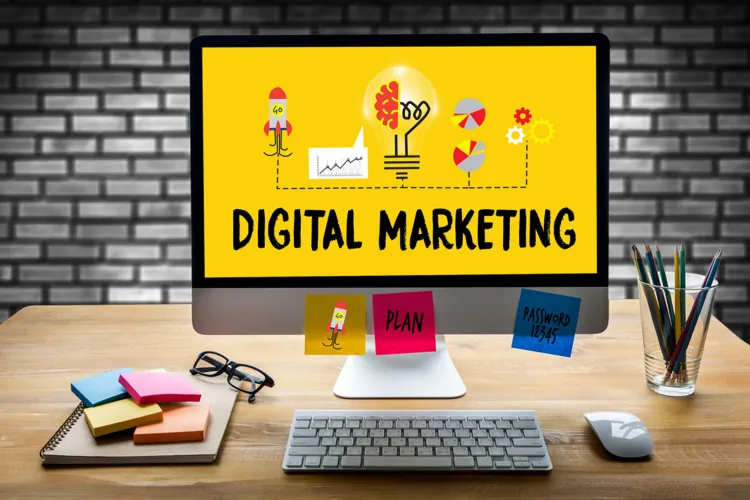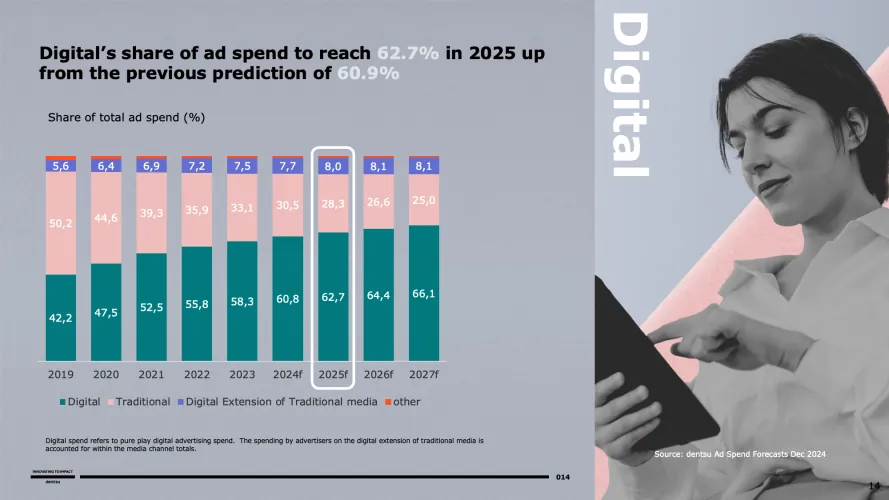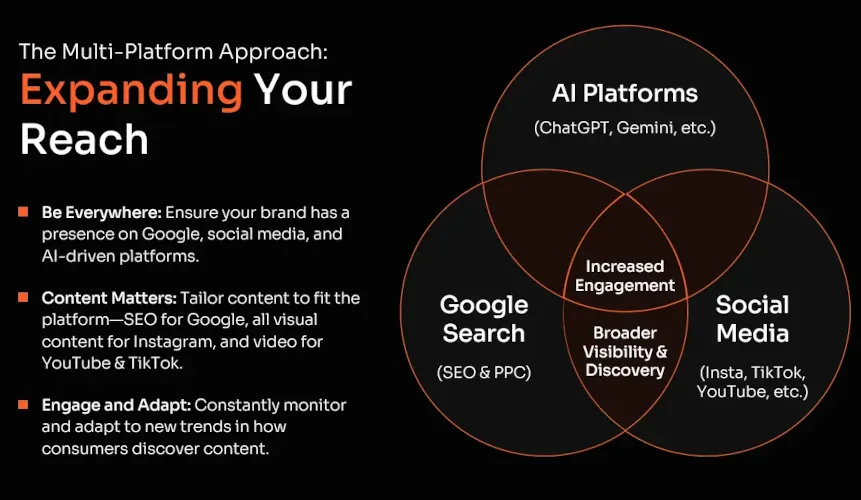How Will the Digital Marketing Landscape Evolve in 2025?

In 2010, Rand Fishkin, co-founder of Moz, famously stated, “If you’re not on the first page of Google, you don’t exist.” Fast forward to 2025, and Fishkin’s perspective has evolved: “Google is absolutely in the mix, but it is not 80-90% of the journey anymore. But the zeitgeist of how people use Google is so much more navigational now and brand-centric…where the customers are is extremely diverse now.”
This shift—from a singular focus on Google rankings to a broader emphasis on customer experience—encapsulates the dramatic transformation digital marketing has undergone over the past 15 years.
As the digital marketing landscape evolves, businesses should take stock of what continues to work in 2025 while keeping pace with the emerging trends revolutionizing the space. With this knowledge, they can harness the power of emerging practices to adapt, innovate, and drive growth.
Navigating the Intersection Between Innovation & Efficacy
As consumer habits shift and technology advances, so do the priorities for digital marketers. Short-form videos, AI personalization, and voice-driven search took center stage in 2024. 2025 presents new challenges for marketers, urging them to deploy innovative strategies to stay one step ahead. Here is a snapshot of how the digital marketing landscape might look in 2025:
- Increased digital marketing budgets will come with heightened competition, requiring businesses to define clear goals and execute strategies with precision.
- Rethinking SEO as searchers move beyond traditional search engines to directly engage with brands across various touchpoints.
- A surge in voice and visual search will demand optimized content that caters to these evolving search behaviors.
- As consumers engage with businesses across multiple touchpoints, they must adopt an omnichannel approach.
- Value-driven branding will forge deeper customer connections as AI-driven personalization becomes a cornerstone of brand-consumer relationships.
Trend #1: Digital Marketing Budgets Will Continue to Rise
As the digital advertising landscape expands, global ad spend will follow suit. In 2024, the global ad spending touched a whopping $772.4 billion. Dentsu reports, “Advertising expenditure growth is expected to continue at 5.9% in 2025, which is considerably higher than the 3.2% growth of the global economy.”

The lion’s share of this increased budget will flow into digital channels—either direct digital advertising or digital extensions of traditional media. However, with this increase in spending comes intensified competition. Without expert guidance, businesses risk overspending in an increasingly crowded marketplace.
In response, brands must strike the right balance between expanding their budgets and ensuring these resources are effectively managed for maximum return on investment. According to Merkle’s CMO survey, 89% of respondents plan on increasing their ad budgets. 18% of these CMOs will be increasing their ad budgets by more than 10%.
Acxiom’s report sheds more light on where these increased budgets may be deployed in 2025. The top 3 objectives of marketing teams in 2025 will be:
Developing MarTech Strategies: Marketers will focus on refining their technology stacks to streamline operations and improve efficiencies.
Increasing Brand Awareness: Social media campaigns, influencer partnerships, and fresh content creation will remain critical to driving visibility.
Acquiring New Customers: Brands will invest in paid ads, SEO, and other tools to broaden their reach and attract new prospects.
Trend#2: Stepping into a New World of Search Optimization
For years, SEO has centered on achieving high rankings in search results. However, as we move into 2025, this focus is shifting.
New Rules of Search on Google
In the new “zero-click” environment, supported by Google, users can search for a query and get their answers without even clicking on a website link. Users get answers to their queries and do not leave Google. The searcher never visits the website. So, ranking high on Google is not enough. You must optimize your content for Google’s new SERP features by including succinct, direct answers for the most common target keywords. Try to get attention within Google because just getting a click is no longer enough.
Think Beyond Google
Digital marketers must broaden their SEO strategies to include a variety of platforms. From AI-powered search engines to social media and voice assistants, potential customers are now searching for brands in more places than ever before. A true omnichannel approach—spanning search engines, AI, paid ads, and social platforms—is crucial for capturing attention at every stage of the customer journey.
Be Agile
Businesses should not back down from adapting to new channels and new trends. They should stay ready for new challenges as their consumers find new ways to find them.

Trend#3: Stepping Up to Sensory Search
Globally, the number of active voice assistant devices doubled in 2024, reaching a staggering 8.4 billion units. The global voice recognition market is projected to reach $26.8 billion in 2025. Voice searches are already popular among searchers and will become more popular and conversational in 2025.
Simultaneously, visual search is gaining traction, especially among Millennials and Gen Z. According to a ViSenze report, 62% of Millennial and GenZ consumers want visual search technology more than any other technology. Gartner also predicts that 30% of all major eCommerce brands will integrate visual search in their platforms.
So, 2025 will make it almost essential for businesses to optimize their content for voice and visual searches. Here is how digital marketers can make changes to their content strategy:
Visual Search Optimizations You Can Make
- Use high-quality, size-optimized images
- Upload product data to Google Merchant Center
- Label images with suitable titles, file names, alt text, embedded or EXIF data, and so on.
- Integrate structured data markup into your HTML
Voice Search Optimizations You Can Make
- Use structured data to increase the probability of reaching a featured SERP snippet
- Claim your Google Business Profile and implement location-based schema markup
- Optimize content to make it conversational
Trend#4: Seamless Customer Journey Across Platforms
Google, Amazon, and other popular platforms are merging features, making it harder for consumers to distinguish between search results, content, and shopping.
To stay competitive, businesses must adapt to these changes by understanding how these platforms are evolving and optimizing their presence across these platforms. These adjustments may include imagery in your content, investment in influencer marketing, and so on.
Whether your customers make text, voice, or visual searches, they should get a seamless experience. They may be browsing through their phone, moving to a desktop website, making an in-store purchase, or making any other contact with your brand. It should feel seamless.
These seamless experiences have been made possible through AI tools. Brands like Target connect their app to in-store purchases. Customers can place orders for pickup or delivery, pluck coupons, or save payment methods, all from one app. Such steps offer an integrated experience and enhance customer engagement. As a first mover, you can invite customers to your brand’s ecosystem. Once they get used to you, it will be easier for your brand to retain them.
Trend #5: Building a Strong Brand Based on Values
Consumers increasingly seek brands aligning with their values, including social responsibility, sustainability, and authenticity. These values are no longer just preferences—they’re expectations. Brands that integrate purpose-driven marketing and user-generated content will cultivate stronger, more meaningful relationships with their audiences, ultimately driving loyalty and retention.
You can build that authenticity with purpose-driven marketing and user-generated content. It will automatically create a competitive edge for your brand. Once the consumers connect with you at a deeper level, it becomes much easier to acquire and more importantly, retain them.
Conclusion
Predicting the future of digital marketing isn’t an exact science, but our deep understanding of trends and technologies equips us to make informed forecasts about what’s to come in 2025.
As digital marketers, adaptability will be key. 2025 will challenge professionals to stay agile, leverage emerging technologies, and remain focused on delivering exceptional customer experiences. By embracing evolving trends like increased digital marketing budgets, AI-driven personalization, omnichannel engagement, and purpose-driven branding, businesses can not only survive but thrive in the rapidly evolving digital landscape.

Leave a Reply